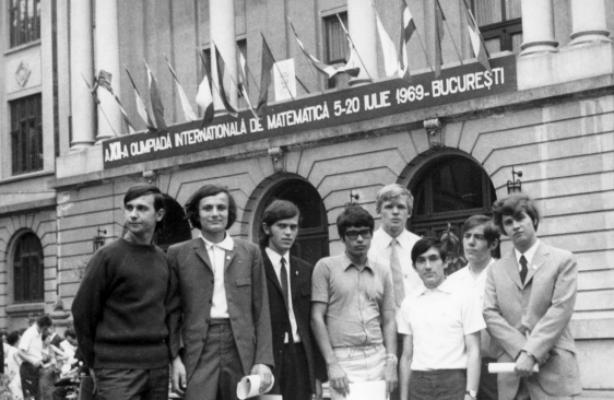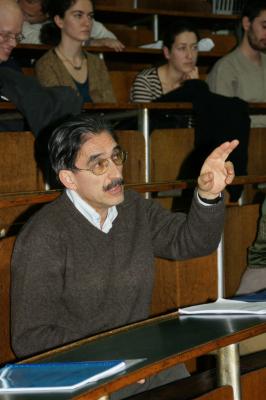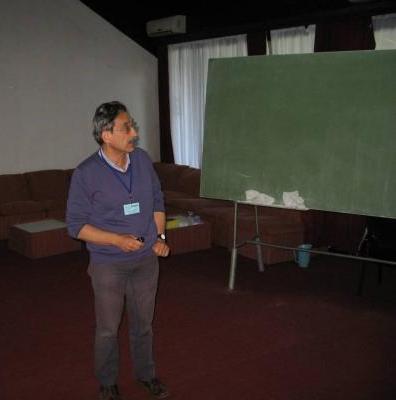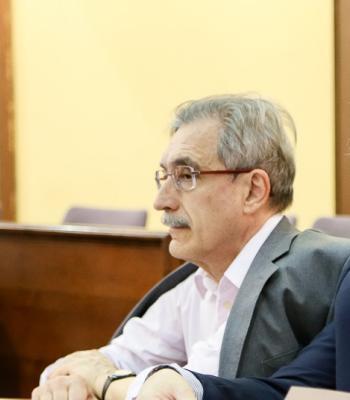Speakers
Branislav Cvetković
Entropy and gravitational interaction (slides)
Abstract:
We review expressions for black holes entropy in various 3D gravity models which deviate from the Bekenstein-Hawking area law. The entropy formulas are strongly influenced by the non-Einstein terms in the gravitational Lagrangian. We discuss possible generalisations to 4D gravity theories.
Mihailo Čubrović
(Non)integrability and the bound on chaos for strings in topological black hole backgrounds (slides)
Abstract:
We study the integrability of the equations of motion of closed strings in topological black hole geometries with flat and AdS asymptotics. Applying the differential Galois theory, we find that some of the higher genus (non-spherical) topologies are integrable for special values of the black hole mass and charge. For generic values, the system is nonintegrable. Numerical computations of the Lyapunov exponents support this conclusion. In nonintegrable cases, the "bound on chaos" conjecture is violated for topologies with multiple windings. We discuss possible implications of this violation for gauge/gravity duality.
Ljubica Davidović
T-duality of an open string with mixed boundary conditions (slides)
Abstract:
We investigate the T-dualization of the modified open string theory, modified to preserve the symmetry transformations possessed by the closed string theory. We take that the coordinates satisfy either Neumann or Dirichlet boundary conditions. We solve these conditions combining the techniques developed in our previous papers, where only Neumann boundary conditions were treated. Namely, we apply the Dirac procedure to the constraints (boundary conditions) expressed in the canonical form and then separate the coordinates and momenta into their even and odd parts, which leads to a solvable form of the constraints. We investigate how the generalized T-dualization procedure applied to an open string, effects the effective closed string theory obtained for the solution of the boundary conditions.
Branko Dragovich
p-Adic string theory (slides 1, slides 2)
Abstract:
p-Adic string theory emerged in 1987 by successful construction of p-adic analog of the Veneziano scattering amplitude for scalar tachyon strings. The novelity was in parametrization of string world-sheet by p-adic numbers, while all other string ingredients remained real or complex. It was shown that product of the ordinary Veneziano crossing symmetric amplitude and its p-adic analog for all prime numbers p is a constant. The next important step in development of p-adic string theory was construction of an effective Lagrangian which describes main properties of p-adic scalar strings.
In this talk I will give an introduction to p-adic numbers, p-adic analysis and a review of some main properties of p-adic strings.
Goran Đorđević
On inflation in the RSII and holographic braneworld (slides 1, slides 2)
Abstract:
A short review of tachyon inflation is presented, including RSII cosmology. A new approach is proposed in the framework of holographic cosmology. The model is based on a holographic braneworld scenario with a D3-brane located at the holographic boundary of an asymptotic ADS5 bulk. Inflation is driven by a scalar tachyon field represented by a DBI action on the brane. The evolution equations are solved and the parameters of the inflation are calculated in the slow-roll regime.
Dragoljub Gočanin
Electrodynamics and Yang-Mills theory in SO(2,3)* model of noncommutative gravity (slides)
Abstract:
The previously established SO(2,3)* model of pure noncommutative (NC) gravity is adapted to incorporate electrodynamics and Yang-Mills theory. By employing the enveloping algebra approach and the Seiberg-Witten map we construct actions for electrodynamics and Yang-Mills theory that are invariant under deformed SO(2,3)* x U(1)* and SO(2,3)* x SU(N)* gauge transformations, respectively. Perturbative expansions of these actions tell us that the first non-vanishing NC corrections are linear in the deformation parameter $\theta^{\alpha\beta}$. These corrections represent new types of coupling between matter and gravity that arise due to spacetime noncommutativity. We analyse, in particular, some unexpected residual effects of noncommutativity in the limit of flat spacetime, e.g. NC deformation of Landau levels of an electron in homogeneous magnetic field.
Michael Haack
On the 1-loop effective action of string compactifications (slides)
Abstract:
I will review the status of 1-loop corrections to the effective action of certain 4-dimensional string theory models with N=1 supersymmetry. Concretely, I will mainly focus on the moduli sector and discuss 1-loop corrections to their sigma model metric, which plays an important role in model building.
Ilija Ivanišević
Courant and Roytenberg bracket and their relations to the current algebra in bosonic string theory (slides)
Abstract:
We investigate a bosonic string moving in a coordinate dependent background. We consider the string sigma action and the totally T-dualized theory, obtained T-dualizing over all coordinate directions using the generalized Busher procedure. In the canonical description, the Hamiltonians of both descriptions are given in terms of the energy-momentum tensors, which can be expressed as products of currents. The currents building the Hamiltonians can be expressed in terms of the currents, (dual) coordinates and momenta. We consider the general currents, defined in terms of the above quantities. It is shown that the algebra of charges associated with these currents is closed under the Poisson bracket and give rise to the Courant bracket in the original and the Roytenberg bracket in the T-dual description. The investigation of the current algebras could enlighten the geometrical structure of the string backgrounds as the structural constants in the current algebras are the background field fluxes.
Nikola Konjik
Noncommutative field theory from angular twist (slides)
Abstract:
We consider a noncommutative field theory with space-time *-commutators based on an angular noncommutativity, namely a solvable Lie algebra: the Euclidean in two dimension. The *-product can be derived from a twist operator and it is shown to be invariant under twisted Poincar´e transformations. In momentum space the noncommutativity manifests itself as a noncommutative *-deformed sum for the momenta, which allows for an equivalent definition of the *-product in terms of twisted convolution of plane waves. As an application, we analyze the λφ^4 field theory at one-loop and discuss its UV/IR behaviour. We also analyze the kinematics of particle decay for two different situations: the first one corresponds to a splitting of space-time where only space is deformed, whereas the second one entails a non-trivial *-multiplication for the time variable, while one of the three spatial coordinates stays commutative.
Aleksandar Miković
Lie 2-groups and quantum gravity (slides)
Abstract:
(tba)
Bojan Nikolić
Type I from type IIB superstring theory via boundary conditions (slides)
Abstract:
We consider type IIB superstring theory with embedded D5-brane and choose boundary conditions which preserve half of the initial supersymmetry. In the canonical approach that we use, boundary conditions are treated as canonical constraints. The effective theory, obtained from the initial one on the solution of boundary conditions, has the form of the type I superstring theory with embedded D5-brane. We obtain the expressions for D5-brane background fields of type I theory in terms of the D5-brane background fields of type IIB theory. We show that beside known $\Omega$ even fields, they contain squares of $\Omega$ odd ones, where $\Omega$ is world-sheet parity transformation, $\Omega:\sigma\to -\sigma$.
Danijel Obrić
Noncommutativity and nonassociativity of closed bosonic string on T-dual toroidal backgrounds (slides)
Abstract:
We consider closed bosonic string in the presence of constant metric and Kalb-Ramond field with one non-zero component, B_{xy} = Hz, where field strength H is infinitesimal. Using Buscher T-duality procedure we dualize along x and y directions and using generalized T-duality procedure along z direction imposing trivial winding conditions. After first two T-dualizations we obtain Q flux theory which is just locally well defined, while after all three T-dualizations we obtain nonlocal R flux theory. Origin of non-locality is variable ∆V defined as line integral, which appears as an argument of the background fields. Rewriting T-dual transformation laws in the canonical form and using standard Poisson algebra, we obtained that R flux theory is noncommutative and nonassociative one. Consequently, there is a correlation between non-locality and closed string noncommutativity and nonassociativity.
Tijana Radenković
Action for scalar, Dirac and gauge fields as 3-BF action with constraints (slides)
Abstract:
First, we will remind you of 2-BF model of guantum gravity --- 2-categorical generalization of BF model and the notion of 2-group (which is equivalent to crossed module) necessary for constructing it. Then, we will see how by considering crossed module for G=SO(3,1)xU(1)xSU(2)xSU(3) instead of G=SO(3,1) we obtain equations of motion for gauge field coupled to gravity known from Einstein-Cartan theory. Finally, we will show how by using the notion of 3-group one can write the action for gravity coupled to scalar and Dirac fields as 3-BF action with constraints.
Voja Radovanović
Noncommutative SO(2,3) model (slides)
Abstract:
(tba)
Igor Salom
To the rescue of Copenhagen interpretation (slides)
Abstract:
In spite of not being related to string theory (if there is anything unrelated to it), this talk will be motivated by a series of recent papers on foundations of quantum mechanics, that seem to dispute some basic tenets of this theory. We revisit these arguments about the (extended) Wigner's friend paradox and offer a new class of explanations, compatible with the essence of the Copenhagen interpretation.
Branislav Sazdović
On the way to M-theory (slides)
Abstract:
This is a brief review of what has been done in collaboration with B. Nikolić and Lj. Davidović in the last few years. In order to get better understanding of M-theory several important steps have been investigated: 1. Generalized Buscher approach to T-duality; 2. Non-geometry and 3. Unification of all T-dual theories in double space.
Marko Vojinović
Unification, higher gauge theory and 3-groups (slides)
Abstract:
We will give a step-by-step overview of the gauge theory construction based on a notion of a 3-group. After we introduce 3-groups in general, we will focus on the relevant example of a 3-group which describes the Standard Model and Einstein-Cartan gravity at the classical level. The 3-group structure features a novel gauge group, intimately connected to the fermion and scalar sectors of the Standard Model. This structure could potentially provide a new insight into the matter sector of the theory, and open new avenues for research on unification of all interactions and matter.



